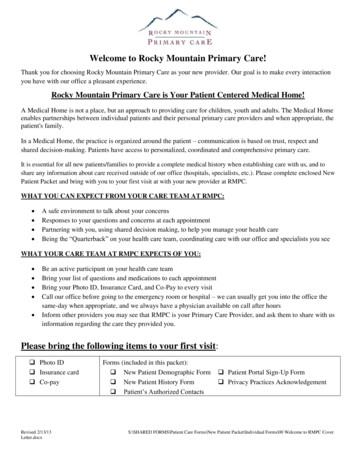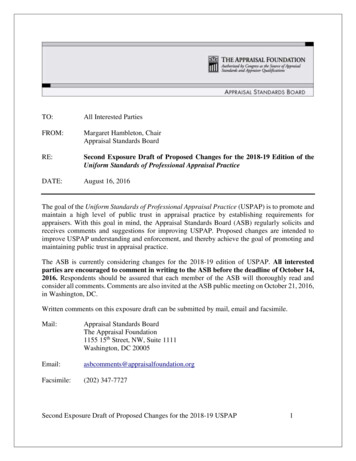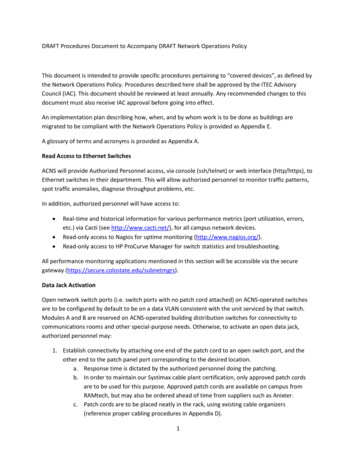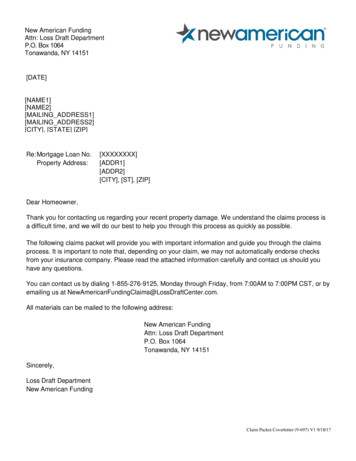
Transcription
Hintermann Series H3 Total Ankle Replacement SystemPATIENT EDUCATIONDRAFTCaution: Federal (USA) law restricts the sale of this device to or on the order of a licensed physician.1DRAFT
Empowering InnovationsTable of ContentsGlossary . 3What is the Hintermann Series H3 . 4Total Ankle Replacement System? . 4Why Doctors Use It . 5Who Cannot Have This Done (Contraindications) . 5Things You Must Do to Avoid Serious Harm (Warnings). 6Things You Must Do to Avoid Other Harm (Precautions) . 6Risks of Using the Hintermann Series H3 TAR . 7Benefits Observed Using the Hintermann Series H3 Total Ankle Replacement System . 8How to Decide About This Treatment . 8What Happens Before the Surgery? . 9What Happens During the Surgery? . 9What Happens After the Surgery?. 9When to Call Your Doctor . 10Where You Can Find Out More . 11Travel . 11How Clinical Studies Were Done . 11More Information About Your Condition . 12Questions & Answers: Hintermann Series H3 TAR . 132DRAFT
GlossaryAnkle joint: the joint between the lower leg and foot. Three bones come together to create the anklejoint: the tibia, the fibula, and the talus.Arthritis: an inflammation of the joints. Arthritis causes joint pain and stiffness. The most common typesof arthritis are osteoarthritis and rheumatoid arthritis.Arthrodesis: a surgery that fuses the three ankle bones together. After surgery you can move your ankleup and down but not side to side.Arthroplasty: a surgical procedure to treat painful conditions of the ankle, the most common beingarthritis. The surgery removes the ankle joint and replaces it with an artificial implant.Cartilage: the tissue that covers the ends of your bones. Healthy cartilage allows your bones to glidesmoothly at your joints. Injured, inflamed, or damaged cartilage can cause pain at your joints.Cortisone: a chemical that your physician injects into your ankle joint to reduce swelling and pain.Fibula: the smaller bone of the lower leg. It is from the knee to the ankle and forms the outsideanklebone.Ligament: a tough band of tissue that holds one bone to another. Ligaments help to provide support toa joint.Non-surgical treatment: any treatment option that does not involve surgery. Typically, it includesmethods to reduce pain for the patient such as pain medications, physical therapy, orthotics, braces,walkers, and compression stockings.Osteoarthritis: occurs when the cartilage becomes thin and eventually wears out, causing bones in theankle joint to rub together. This causes pain and the loss of movement in the joint.Post-traumatic arthritis: arthritis that develops after a sports injury, car accident, or from a recurringinjury.Rheumatoid arthritis: occurs when the cartilage around the ankle joint becomes inflamed because of animmune system activity. This is one of the most serious type of arthritis. It occurs more often in womenthan men.Talus: the anklebone. The talus is located between the heel bone (calcaneus) and the fibula and tibia.The bone connects the leg and foot so the body’s weight can be transferred which allows a person towalk.Tendon: a tough piece of tissue that connects muscle to bone.Tibia: the large bone of the lower leg. It is from the knee to the ankle and forms the inside anklebone. Itis more commonly referred to as the shin bone.3DRAFT
What is the Hintermann Series H3 Total Ankle Replacement System?The Hintermann Series H3 TAR, also referred to as H3 , is a three-part total anklereplacement (TAR) prosthesis (artificial body part): Metal Tibial Part – the upper part of the TAR thatcovers the upper part of your ankle joint, which isthe bottom of the tibia (shin bone). Polyethylene Sliding Insert (PE Inlay) – the middlepart of the TAR is made of polyethylene (plastic). Itsits between the upper and lower metal parts toallow the ankle to move. Metal Talar Part – the lower part of the TAR thatcovers the lower bone of the ankle joint, the talus.The Hintermann Series H3 TAR tibial and talar components are made from a metal calledCobalt Chromium alloy. They have two coats of porous Titanium and Hydroxyapatite (a ceramic likematerial) on the sides that have contact with (touch) the bones. This coating promotes bone growth intothe tibial and talar metal parts.4DRAFT
Your ankle joint is located where your leg and footmeet and is made of three bones:the fibula (leg bone), the tibia (shin bone), andthe talus (ankle bone).A layer of cartilage (padding) pads the joint andallows the bones to move easily. If the cartilage isdamaged, it can cause pain, and maycause the bone to wear down.Why Doctors Use ItDoctors use the Hintermann Series H3 TAR to replace your ankle joint when you have had ankle painfrom arthritis (a condition that causes pain, stiffness, swelling, and even warmth at the ankle) for a longtime. There is no cure for arthritis.The Hintermann Series H3 TAR is indicated for use as a non-cemented implant to replace a painfularthritic ankle joint due to primary osteoarthritis, post-traumatic osteoarthritis or arthritis secondary toinflammatory disease. Primary osteoarthritis: arthritis that occurs when the protective padding on the ends of yourankle bones wears down over time Post-traumatic arthritis: arthritis that is caused by an injury to the ankle. Arthritis secondary to an inflammatory disease: arthritis that is caused by an inflammatorydisease (disease that causes the body’s defense system to attack the ankle)Who Cannot Have This Done (Contraindications)The Hintermann Series H3 TAR should not be used if you have any of the conditions listed below. Yoursurgeon will help you understand if any of these conditions apply to you. Skeletal immaturity (bones that are not fully grown)Poor quality bone that keeps the bone from supporting the implanto Some conditions that cause poor bone quality are osteopenia and osteoporosis(conditions where bones become brittle and may break)o Avascular necrosis (death of bone due to lack of blood) of the talusInfection now or in the past in the ankle joint or the bones next to the ankle5DRAFT
Poor ankle alignment (ankle bones not lined up correctly) or severe deformity of the ankle ornearby bones and joints.o These problems can keep your foot from being flat to the groundo Poor knee alignment (knee bones not lined up correctly)o Poor support from ankle ligaments (tissue that holds the ankle joint together) thatcannot be repaired during surgery Charcot joint (disease that destroys bones and soft tissues) or peripheral neuropathy(numbness, weakness or pain in your ankle and foot) that can cause Charcot joint of the affectedankle such as diabetesPoor muscle function around the ankleNot enough blood flowing to the bones of your footPoor skin and soft tissue quality around the surgical areaImmunosuppressive therapy (medications that decrease your ability to fight infection)Prior ankle fusion or revision (replacement) of total ankle replacementHigh demanding sport activities (e.g. contact sports, jumping)Suspected or documented metal allergy or intolerance Things You Must Do to Avoid Serious Harm (Warnings)Serious complications after surgery with the Hintermann Series H3 TAR may occur if you: Are not in good general physical condition Have severe osteoporosis (a condition that causes poor bone quality) Have body or bodily structure abnormalities Have allergies or other reactions to foreign (not normally found in the body) materials Have disorders that affect the whole body or disorders caused by abnormal chemical reactionsin your body Have a severe deformity (part of the body that is not normal)Things You Must Do to Avoid Other Harm (Precautions) The Hintermann Series H3 TAR requires special training to be implanted correctly. Pleaseask your surgeon whether he or she has been trained to implant the Hintermann Series H3 TAR . It is important to follow your surgeon’s advice regarding which activities you should not doafter undergoing a Hintermann Series H3 TAR . This advice will likely include no running,jumping, or heavy work (work that requires manual labor or lifting heavy items). Not6DRAFT
following this advice may cause the TAR to wear out early, loosen or break or cause abroken bone. Any of these problems might require additional surgery to replace all or partof the TAR or to remove the TAR and fuse your ankle (join your ankle bones together).Risks of Using the Hintermann Series H3 TARThe complications that may occur when using the Hintermann Series H3 TAR are: Fractures of bones next to the ankle implant area during and after surgery Soft tissue injuries at or next to the surgical area during surgery with injury to blood vesselsor nerves Malalignment (not lined up correctly) of the ankle during surgery Infection in area of the incision (cut in skin during surgery) or an infection involving the TAR Loosening of the TAR parts Bone loss of the tibia, talus or fibula Sinking of the TAR parts Problems with the polyethylene (plastic) TAR inlay part such as fracture (breaking), wear(wearing out) and making the ankle unstable Arthritis in nearby areas Lack of ankle motion due to scar tissue, friction, or muscle or ligament tightness Avascular necrosis of the talus (death of ankle bone due to lack of blood) Long lasting pain, extreme sensitivity and pain Swelling Bone growth in unusual areas like soft tissues Numbness, weakness or pain in your ankle and foot Blood clot that stops blood from flowing in a blood vessel Wound healing problemsAny of these complications could require treatment such as medicine or another operation that couldinvolve replacing or removing part or all of your TAR.A study of 298 patients who had the Hintermann Series H3 TAR was conducted. The adverse events(complications) related to the Hintermann Series H3 TAR that were reported in the study are listedbelow in Table 1. Five of the adverse events were ongoing and had not been treated when the studyended.Table 1: Adverse Events Related to the Use of Hintermann Series H3 TARTotal number ofpatients forPercent (%)whom thisof patientsDescription of Adverse EventTreatment or testingadverse eventwho hadrelated to the use of the H3needed due to thiswas reported outthisTARadverse eventof the totaladversenumber of hipseventin the studyLong Lasting Pain1/2730.4%Tibia post replaced7DRAFTNumber ofpatientsneeding thistreatment1
Total number ofpatients forPercent (%)whom thisof patientsNumber ofDescription of Adverse EventTreatment or testingadverse eventwho hadpatientsrelated to the use of the H3needed due to thiswas reported outthisneeding thisTARadverse eventof the totaladversetreatmentnumber of hipseventin the studyAseptic Loosening2/2730.7%Ankle fused1Inlay replaced1Aseptic Loosening- Tibia1/2730.4%Tibia part replaced1Bone Loss1/2730.4%Ongoing, no treatment1Bone Loss - Talus1/2730.4%Talas part replaced1Bone Loss – Tibia2/2730.7%Ongoing, no treatment1Fracture - Inlay Part2/2730.7%Tibia part replaced1Inlay replaced;1hindfoot/midfoot fusionWear – Inlay Part2/2730.7%Inlay replaced11 or both metal parts1replaced; cheilectomySinking – Talus Part4/2731.5%Talus part replaced &1ligaments repairedTalus part replaced1Ongoing, no treatment2Sinking – Talus & Tibia Parts1/2730.4%Ongoing, no treatment1Sinking – Tibia Part1/2730.4%Ankle fused1Benefits Observed Using the Hintermann Series H3 Total Ankle Replacement SystemGood results after TAR surgery are not guaranteed, but TAR surgery may help you return to amore active life and may reduce pain and improve the motion in your ankle joint.The results of a study of the Hintermann Series H3 TAR in patients who had TAR surgery areincluded in the section called “What Are the Results of Studies of the Hintermann Series H3 TAR System?” These results describe the benefits these patients experienced.How to Decide About This TreatmentDiscuss the possible risks and benefits associated with this surgery with your surgeon and with yourfamily or caregiver to decide if the Hintermann Series H3 TAR is the right treatment for you.8DRAFT
What Happens Before the Surgery?Before surgery, your surgeon wants you to be as healthy as you can be. In the weeks before yoursurgery, you need to: Schedule your pre-operative (before surgery) visit with your surgeon;Have a general physical examination by your primary care physician;Find out if you need to stop taking any medicine before your surgery;If you smoke, think about quitting;Lose some weight if your surgeon tells you to;Get any lab tests that may be needed;Speak to a physical therapist;Plan for any care and therapy you may need after your surgery; andFast (do not eat or drink) the night before your surgery.What Happens During the Surgery?Total ankle replacement surgery removes the damaged parts of the ankle joint and installs new parts intheir place. The surgeon cuts through the skin on the front of the ankle and then cuts the tibia (shinbone) and talus (ankle bone) to remove the damaged cartilage (padding) and make room for the ankleimplant. After surgery, the foot is placed in a splint (bandage that will not bend that keeps the anklefrom moving).What Happens After the Surgery?Usually, two to four days after TAR surgery, your foot is placed in a cast for about six weeks to keep yourfoot from moving. Most patients will have some pain for the first two weeks after surgery. This painshould decrease over time and with prescribed, or over-the-counter, pain medication. In addition, limitthe weight you place on your ankle for the first week or two after surgery. When you move around, usea wheelchair, scooter, or crutches. Also, keep your foot raised as much as possible after surgery to helpwith healing.Your surgeon will watch how you heal and usually six weeks after surgery, you may return to yournormal daily activities. Once your surgeon allows you to, you can walk, swim, and even take part in nonimpact sports, such as golf or hiking. Do not run, jump, or lift anything heavy unless your surgeon saysyou can. These types of activities could cause the device to wear out too quickly, loosen, or break, whichmay require additional surgery. Speak with your surgeon if you have any questions about activities notlisted.Even when your surgeon allows you to return to your normal daily activities, you may have some painfor up to three months after your surgery. Also, you may see some slight swelling of your ankle for up to9DRAFT
a year after surgery. Your surgeon may suggest wearing a compression stocking (a long sock that gentlysqueezes your leg to move blood up your leg) to avoid swelling for four to six months following yoursurgery.How your TAR implant wears over time is based on a variety of conditions. Recent studies show thatthere is a 94% chance your TAR will still work well after five years of use, and an 80% chance that yourTAR will still work well after ten years without any changes to the implants.1When to Call Your DoctorCall your surgeon if you experience any of the following: Signs of infection (if you have a fever, chills, redness around your incision, increasedpain, the feeling of pressure in the ankle, or trouble walking). Infection can cause animplant to fail and require you to have a second surgery to remove or replace theankle implants. Bleeding or excessive drainage (continued oozing of liquid) from your incision(s) thatis more than what your surgeon told you to expect. Too much bleeding or drainagemay be a sign that your wound is not healing correctly and you need to have yoursurgeon examine it. You may need to take medicine, or you may need to have theincision re-opened to make sure it will heal correctly. Severe pain that comes on quickly or an increase in your pain level that limits yourability to function. This kind of pain may indicate that there is a problem with yourankle implant and you should call your surgeon to see if you should be examined. Loss of sensation (feeling), or significantly decreased sensation (your feeling is dull ornumb) in your leg/foot. This may indicate that there is a problem with your hipreplacement and you should call your surgeon to see if you should be examined. Ongoing changes in your medical condition. You and your surgeon will need to decide if yourmedical condition or surgery could make it more likely that the Hintermann Series H3 Anklemay break, loosen or fail, or that your bones may be damaged. This could lead to the needfor additional treatment, including surgery.1Barg et al. “HINTEGRA Total Ankle Replacement: Survivorship Analysis in 684 Patients.”(July 2013). Journal of Bone and Joint Surgery America.http://jbjs.org/content/95/13/117510DRAFT
Where You Can Find Out MoreThis document is provided to give you information about your treatment choices. It is notintended to replace advice from a doctor. If you have any further questions or need additionalinformation about the Hintermann Series H3 TAR, speak with your surgeon.The company that makes the Hintermann Series H3 TAR is:DT MedTech, LLC110 West Road, Suite 227Baltimore, MD 21204Telephone: (410) 427-0003TravelDue to the metal in your ankle replacement, metal detectors may be affected. A patient ID card will beprovided to you by the manufacturer through your surgeon. The card will identify you as having a totalankle replacement that may activate these devices. When passing through an electronic detectionsystem you may use this card to notify security of your implant.How Clinical Studies Were DoneOne clinical study compared the safety and effectiveness of the 298 patients with the Hintermann SeriesH3 TAR to a Performance Goal (PG) based on the published literature and registry data of anotherlegally marketed TAR system (control device).All of the H3 TAR study patients had ankle arthritis that was not relieved by non-surgical treatments.Each patient’s pain and ankle function were recorded before and after the TAR surgery.Safety InformationThe primary safety assessment for this study compared the H3 TAR Serious Adverse Device-RelatedEvents (SADEs) reported in the study and combined SADEs reported for the H3 TAR in the literature anda national joint registry to the combined SADEs reported for the control device in publications and anational joint registry.Among the three groups compared, the H3 study group had the lowest rate of SADEs (16 out of 273patients or 5.9%), although the H3 literature rate was very similar (146 out of 243.7 or 6.0%). The SADErate for the control group (316 out of 3020 patients or 10.5%), was significantly higher than those forthe H3 TAR.11DRAFT
The rate of replacement or removal of the H3 TAR in the study (27 out of 273 patients or 9.9%) and inthe literature (134 out of 2437 patients or 5.5%) was lower than that for the control group (391 out of3020 patients or 12.9%).Additional safety results of this study are shown in the section titled, “Risks of Using the HintermannSeries H3 TAR.”Effectiveness InformationThe study had 3 co-primary effectiveness endpoints:1. American Orthopaedic Foot and Ankle Society (AOFAS) Hindfoot Score at least 2 years aftersurgery The AOFAS Hindfoot Score is a score that covers three categories: pain, function andrange of motion, and ranges from 0 (worst) to 100 (best).2. Survivorship (no TAR parts replaced or removed) within 5 years of surgery, and3. Rate of patients with a serious complication related to the TAR (SADE) other than a replacementor removal of 1 or more TAR parts within 2 years after surgery.The PG for the AOFAS score at least 2 years after surgery was 71 and the average for the HintermannSeries H3 TAR was 78 with a lower 95% confidence limit of 76.12. The PG for Survivorship was 0.83and for the Hintermann Series H3 TAR was 0.912 with a lower 95% confidence limit of 0.878. The PGfor the rate of subjects with an SADE was 0.937 and for the Hintermann Series H3 TAR was 0.963 witha lower 95% confidence limit of 0.939. For all 3 co-primary effectiveness endpoints, the HintermannSeries H3 TAR results were higher than the PGs. Thus, the H3 TAR is an effective treatment for apainful arthritic ankle joint due to primary osteoarthritis, post-traumatic osteoarthritis or arthritissecondary to inflammatory disease.The rate of replacement or removal of the H3 TAR in the study (9.9%) and in the literature (5.5%) waslower than the rate of 12.9% for the control device.Additional safety results of this study are shown in the section titled, “Risks of Using the HintermannSeries H3 TAR.”More Information About Your ConditionAlthough your surgeon is planning to use the Hintermann Series H3 TAR for your anklereplacement, you should be aware that there are alternative (other) treatments. Patients, withtheir surgeon’s help, are likely to choose from one or more of the following options. No treatment. With this option, your surgeon will continue to watch your ankle but will adviseyou to delay having ankle surgery. Your surgeon may prescribe over-the-counter or prescription pain medication for your anklepain. Your doctor may suggest wearing a brace, orthotics (shoe inserts), or using a cane to putless pressure on your ankle joint and tell you to avoid any activities that may cause you pain. Or,12DRAFT
your doctor may inject cortisone into your ankle joint to help relieve pain. These treatments canrelieve some of the pain caused by arthritis but will not cure the disease. When non-surgical treatments no longer work, your doctor may recommend surgery.oOne surgical procedure, arthrodesis (ankle fusion), is fusing your ankle joint (joining thebones together) to decrease the movement of the ankle. While ankle fusion limitsmotion, it can permit the resumption of heavy lifting or more vigorous activities, unliketotal ankle replacement. Many studies also suggest that the need for further surgicalprocedures is less with ankle fusion than TAR.oAnother surgery is total ankle replacement (TAR) where implants are placed on the tibia(shin bone) and talus (ankle bone) to create a new ankle joint. Some TAR implants have2 parts and some have 3 parts. The Hintermann Series H3 TAR has 3 parts.Questions & Answers: Hintermann Series H3 TARQ: What is the typical length of hospital stay after TAR surgery?A: Usually, TAR patients stay in the hospital for two or three days after surgery. During this time yoursurgeon will watch your progress to see if you require additional recovery time.Q: Are my activities restricted after TAR surgery?A: Yes. usually two to four days after TAR surgery, your foot is placed in a cast or you will be givenwalker to use. Do not place any weight on your ankle for at least two weeks after surgery. Use crutches,a walker, or a wheelchair for this period or until your surgeon tells you to begin putting weight on yourankle again. Typically, you can put full weight on your ankle four weeks after surgery. Your cast will beremoved, or you can quit using your walker about six weeks after surgery. Until then, there will berestrictions on your activities.Q: When can I return to my normal daily activities?A: Your surgeon will tell you when you can walk, swim, and participate in non-impact activities such asgolf or hiking. Do not run, jump, or lift heavy items without discussing this with your surgeon first. Thesetypes of activities place a stronger force on the ankle implant and may cause it to wear out early, loosen,or break. It could also cause pain and require additional surgery to fix the issue. Discuss with yoursurgeon any activities not listed to see if they may be continued, or if some modification is needed.Q: When can I return to work?A: Before returning to work, think about your rate of recovery and pain tolerance. Also look at your jobdescription and what your employer will do to minimize chances of injury to your ankle. This includesgetting to work, parking, getting to your work area, being able to rest, and to elevate (raise) your foot. Ifyou perform physical work, you may return to work once you are able to stand and walk for as long atime as your work requires, which may not be until three to four months after surgery. Your doctor mayalso recommend that you change to lighter work to protect your new ankle.13DRAFT
Q: How long until I can drive?A: Before returning to driving, you need to quit taking all prescription pain medications. Patients whohave minimal pain and a car with automatic transmission may be able to drive about two months aftersurgery.Q: Will my insurance cover my TAR surgery?A: Yes, this procedure is usually covered by most major insurance carriers along with Medicare andMedicaid. However, you should speak with your insurance provider to determine coverage under yourspecific plan.Q: What happens should I ever need an X-ray or MRI, or need to pass through a metal detector?A: Since certain parts of your Hintermann Series H3 TAR prosthetic are made of metal, your surgeonwill issue you a card from the manufacturer stating you had a device implanted in your ankle that maybe dangerous to you if you have an MRI and may activate metal detectors. Be sure to carry this cardwith you at all times, especially when getting x-rays or MRIs, and ask your physician if it is safe for you tohave an MRI. Also have this card available when passing through metal detectors.Q: Are the materials in the Hintermann Series H3 TAR prosthesis safe for implantation?A: Yes. The materials used in the Hintermann Series H3 TAR prosthesis (i.e., Cobalt Chromium alloy,Titanium, Hydroxyapatite, and Polyethylene) are the same materials that have been used in otherprosthetic devices, such as hip and knee replacements, for the last 40 years.Q: What is the difference between the Hintermann Series H3 TAR implant surgery and ankle fusion(ankle arthrodesis) surgery?A: The Hintermann Series H3 TAR system was designed to maintain your ankle's normal range ofmotion (movement) after removing the painful arthritis. Arthrodesis fuses the ankle bones together torelieve your arthritic pain but limits your ankle's range of motion. However, it is important to rememberthat some pain may remain due to pre-existing damage to the surrounding soft-tissues.There is no guarantee that additional surgeries will not be needed after both surgical techniques. Whileankle fusion limits motion more significantly, it can permit the resumption of heavy lifting or morevigorous activities, unlike total ankle replacement. Many studies also suggest that the need for furthersurgical procedures is less with ankle fusion than TAR. However, with the Hintermann Series H3 TARyou will maintain some of the movement of your ankle, which may allow you to continue with most ofyour daily, normal activities after recovery. It is generally believed that by maintaining ankle motion, lessstress is placed on the body as a whole and may limit development of arthritis in the joints next to yourTAR.14DRAFT
mPMA Draft Rev 2This patient education brochure is presented by DT MedTech, LLC to provide an overview of ankle replacementsurgery, and does not include all information needed to determine eligibility for this ankle replacement device orfor the proper use and care of this implanted device. Patient results may vary, as results depend on personalcircumstances. How long an ankle replacement lasts, also varies from person to person. There is no guarantee itwill last for the rest of a patient’s life and it may need to be replaced at some point-in-time. We ask that you pleaseconsult your physician to determine if this product is right for you.DT MedTech, LLC110 West Road/Suite 110Towson, MD 21204USA 2016 DT MedTech, LLC.15DRAFTAll rights reserved.
of arthritis are osteoarthritis and rheumatoid arthritis. Arthrodesis: a surgery that fuses the three ankle bones together. After surgery you can move your ankle . orthotics, braces, walkers, and compression stockings. Osteoarthritis: occurs when the cartilage becomes thin and eventually wears out, causing bones in the











